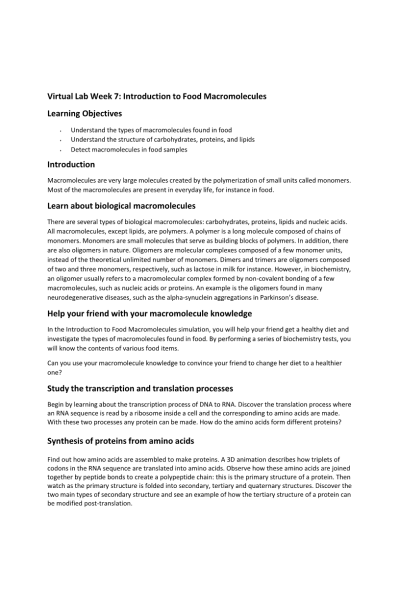CHEM 120 Week 7 Virtual Lab; Part I, Part II, Part III
-
$25.00
| Institution | Chamberlain |
| Contributor | Karin Austin |
Document Preview
Virtual Lab Week 7: Introduction to Food Macromolecules Learning Objectives
- Understand the types of macromolecules found in food
- Understand the structure of carbohydrates, proteins, and lipids
- Detect macromolecules in food samples
Introduction
Macromolecules are very large molecules created by the polymerization of small units called monomers. Most of the macromolecules are present in everyday life, for instance in food.
Learn about biological macromolecules
There are several types of biological macromolecules: carbohydrates, proteins, lipids and nucleic acids. All macromolecules, except lipids, are polymers. A polymer is a long molecule composed of chains of monomers. Monomers are small molecules that serve as building blocks of polymers. In addition, there are also oligomers in nature. Oligomers are molecular complexes composed of a few monomer units, instead of the theoretical unlimited number of monomers. Dimers and trimers are oligomers composed of two and three monomers, respectively, such as lactose in milk for instance. However, in biochemistry, an oligomer usually refers to a macromolecular complex formed by non-covalent bonding of a few macromolecules, such as nucleic acids or proteins. An example is the oligomers found in many neurodegenerative diseases, such as the alpha-synuclein aggregations in Parkinson’s disease.
Help your friend with your macromolecule knowledge
In the Introduction to Food Macromolecules simulation, you will help your friend get a healthy diet and investigate the types of macromolecules found in food. By performing a series of biochemistry tests, you will know the contents of various food items.
Can you use your macromolecule knowledge to convince your friend to change her diet to a healthier one?
Study the transcription and translation processes
Begin by learning about the transcription process of DNA to RNA. Discover the translation process where an RNA sequence is read by a ribosome inside a cell and the corresponding to amino acids are made.
With these two processes any protein can be made. How do the amino acids form different proteins?
Synthesis of proteins from amino acids
Find out how amino acids are assembled to make proteins. A 3D animation describes how triplets of codons in the RNA sequence are translated into amino acids. Observe how these amino acids are joined together by peptide bonds to create a polypeptide chain: this is the primary structure of a protein. Then watch as the primary structure is folded into secondary, tertiary and quaternary structures. Discover the two main types of secondary structure and see an example of how the tertiary structure of a protein can be modified post-translation.
Part 1: Complete Labster Lab: Introduction to Food Macromolecules
Purpose: Describe in complete sentences and in your own words, the purpose of this experiment.
The purpose of this exercise was to provide education on macromolecules such as carbohydrates, proteins, and lipids, including their components and functions in the human body……….. Continue
| Instituition / Term | |
| Term | Summer |
| Institution | Chamberlain |
| Contributor | Karin Austin |





-80x80.JPG)



-80x80.JPG)





























































